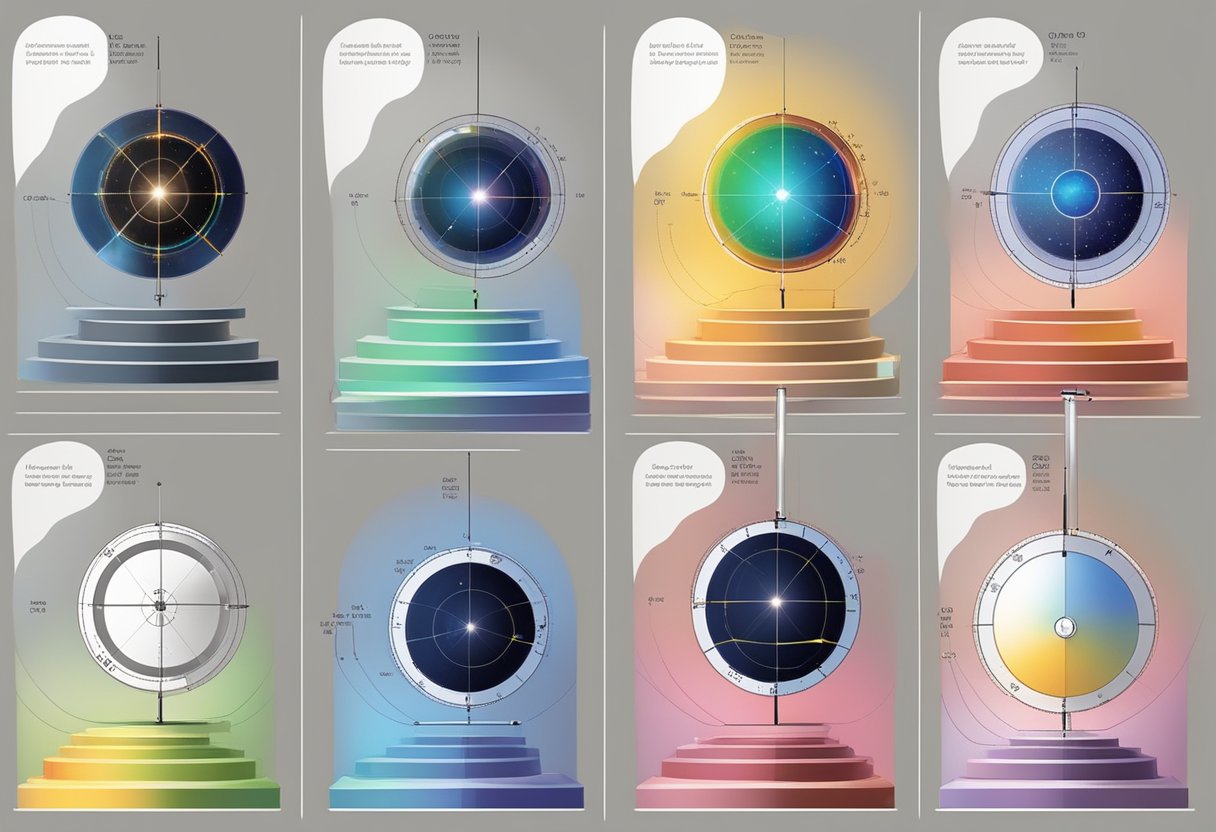Astronomers have developed various methods to determine the temperature of stars, which is a fundamental parameter in understanding a star’s physical characteristics and lifecycle.
The color of a star, which is dependent on its temperature, is one of the most observable indicators. Cooler stars emit light at longer wavelengths, giving them a redder appearance, while hotter stars emit at shorter wavelengths, leading to a bluer color. This color-temperature relationship allows astronomers to estimate the surface temperature of a star from its spectral classification.
Another common method is using the principles of thermal radiation. Every object emits radiation in the form of black-body radiation, which depends on its temperature. By studying the spectrum of a star, astronomers can apply Planck’s law to measure the radiation curve and calculate the effective temperature.
More sophisticated techniques, such as interferometry, allow astronomers to measure a star’s angular size and, along with the star’s brightness, use these data to derive the temperature.
Astronomers measure the temperature of stars using color and spectral classification, applying black-body radiation principles and Planck’s law. Techniques like interferometry help calculate temperatures accurately.
Fundamentals of Stellar Temperature Measurement
Measuring the temperature of stars is essential to understanding their properties, lifecycle, and the evolution of galaxies. This process directly involves analyzing the emitted light and applying laws of thermal radiation.
Blackbody Radiation
Every star emits radiation similarly to a blackbody; an idealized physical body that absorbs all incident electromagnetic radiation, regardless of frequency or angle of incidence. When you observe a star, you’re actually seeing blackbody radiation, which allows astronomers to deduce a star’s temperature.
Wien’s Law
Wien’s Law states that the blackbody radiation curve for different temperatures will peak at wavelengths inversely proportional to the temperature. Specifically, the formula is:
λ_max = b / T
where λ_max is the peak wavelength, b is Wien’s displacement constant (approximately 2.897 x 10^-3 m K), and T is the temperature of the blackbody in kelvin. By measuring the peak wavelength of a star’s spectrum, you can calculate its effective temperature.
Spectroscopy
Spectroscopy is the practice of splitting light into its component colors to study the resulting spectrum. Each star has a unique spectrum, from which you can infer various characteristics, including temperature. The absorption lines in the spectrum, caused by elements in the star’s atmosphere, can change position and shape with temperature, providing key temperature indicators.
Observational Techniques
Identifying the temperature of distant stars is crucial to understanding their properties and place in the evolution of the universe. Here’s how astronomers precisely measure these temperatures using different observational techniques.
Photometry
Photometry is the measurement of the intensity of a star’s light. By observing how bright a star appears through different filters, you can infer its temperature. The brightness of a star is related to its temperature where hotter stars will appear brighter in the blue part of the spectrum, while cooler stars shine more brightly in the red.
Spectrophotometry
In spectrophotometry, you examine the distribution of a star’s light across the entire spectrum. A star’s spectrum holds key details about its temperature. When you analyze the spectrum, you’ll notice absorption lines—specific wavelengths where light is absorbed by elements in the star’s atmosphere. The pattern and intensity of these lines can reveal the star’s temperature since each element absorbs light differently depending on the temperature.
Filter Systems
A variety of filter systems are used in observing stars; among them, the UBV system is widely utilized. This system includes ultraviolet (U), blue (B), and visual (V) filters, which correspond to different wavelengths. The color index, obtained by comparing measurements through different filters, is a method to calculate the temperature of a star. For instance, a high B-V index indicates a star that is cooler and therefore redder, while a low B-V index points to a hotter, bluer star.
Observational Astronomy and Astronomy Methods are resources that detail these techniques for measuring stellar temperatures.
Temperature Classification of Stars

Astronomers classify stars by temperature using spectral types and by their position on the Hertzsprung-Russell diagram, each method providing valuable insights into a star’s characteristics.
Harvard Spectral Classification
In the Harvard Spectral Classification system, stars are sorted into categories based on their spectral characteristics, which correspond closely with their surface temperatures. For instance, an A1 star retains specific spectral features indicative of its temperature range. These types are labeled O, B, A, F, G, K, and M, ranging from the hottest to the coldest stars. A mnemonic to remember this sequence is “Oh Be A Fine Girl/Guy, Kiss Me.”
Hertzsprung-Russell Diagram
The Hertzsprung-Russell Diagram plots stars according to their absolute magnitude (brightness) against their effective temperatures. Differences in star temperatures are evident where they fall on the diagram: hot, luminous stars occupy the upper left, whereas cooler, dimmer stars are found on the lower right. Your understanding of a star’s temperature can be enhanced by locating it on the diagram with respect to known benchmarks such as G and K stars.
Challenges in Measuring Stellar Temperatures
When you delve into the study of stars, understanding how their temperatures are measured is fundamental. However, this process is not without its challenges.
Interstellar Dust and Gas
Interstellar dust and gas are significant impediments to accurately measuring stellar temperatures. These materials can absorb and scatter the light emitted from stars, leading to a reddening effect. This effect causes the starlight that reaches Earth to appear cooler than it actually is, hence complicating the temperature determination process.
Stellar Variability
Another factor complicating temperature measurement is stellar variability. Some stars exhibit changes in brightness and temperature over time. These variations can be regular, as in the case of pulsating variables, or irregular, such as those caused by stellar spots or flares. Monitoring such variability requires sustained observation, making it a laborious task to deduce precise temperatures.
Innovations in Temperature Measurement
Astronomers have developed innovative methods to determine the temperatures of stars, extending our understanding of stellar properties. With advancements in technology and spectroscopy, you can comprehend how these measurements are obtained with greater precision.
Spectroscopy is the key technique exploited by astronomers. By analyzing the spectrum of light emitted by a star, you discern features that correspond to specific elements and the conditions in which they exist, such as temperature. Spectral lines are fingerprint-like patterns in the light, which narrow or broaden based on temperature.
Innovations in Spectral Analysis:
- Advanced algorithms can now more accurately deconstruct spectra to estimate stellar temperatures.
- New telescopes with high-resolution spectrometers gather more detailed spectral data, lending to improved temperature estimations.
Interferometry also plays a role in measuring stellar temperatures. This method involves combining light from multiple sources to form an interference pattern, which reveals details about a star’s size and, in turn, temperature.
Recent technological developments that enhance these methods include:
- CARMENES Instrument: designed to study very cool stars, it provides data to determine their temperatures and masses without specific temperature stabilization.
- Angular Diameter Predictions: Leveraging high-precision measurements, astronomers can infer temperatures from the angular size of a star in direct relation.
In-depth experiments and continuous calibration of instruments ensure accuracy in these temperature measurements. By combining observations with theoretical models, you can deduce temperatures of stars from data produced by these innovative techniques. The advancements observed over the years in the field of temperature measurement of stars signify the importance and complexity of the task, reflecting a continuous quest for precision in the characterization of our universe.
Applications in Astrophysics
In the field of astrophysics, measuring the temperature of stars is pivotal to advancing our understanding of stellar objects and the cosmos at large. The methods employed for this task have significant applications in determining the lifecycle of stars and discovering new planets.
Star Formation
To comprehend how stars are born, you must look at clouds of gas and dust known as nebulae. The temperature of these clouds, ascertained through spectral analysis, tells astronomers about their potential to collapse into new stars. By measuring the temperatures and luminosities of different star-forming regions, astronomers can trace the early stages of stellar evolution. These measurements shed light on how initial conditions translate into various star sizes and types.
Exoplanet Discovery
Your knowledge of star temperatures also plays a crucial role in the search for exoplanets. The transit method, one of the primary means of exoplanet discovery, involves detecting slight dimming of a star as a planet passes in front of it. To accurately calculate the size and composition of an exoplanet, the star’s temperature is essential. The drop in brightness is nuanced, and understanding the baseline temperature allows astronomers to determine the signature of a planet versus natural stellar fluctuations.
Frequently Asked Questions
Understanding how astronomers measure the temperature of stars is central to the study of stellar properties and behavior.
What technique is used to determine the temperature of a star?
The primary technique for determining the temperature of a star is through spectroscopy, which analyzes the light emitted by a star to extract temperature information.
How does the color of a star indicate its temperature?
A star’s color is directly related to its temperature. Blue stars are hotter than red stars due to the difference in energy output at various temperatures.
What role does spectroscopy play in measuring stellar temperatures?
Spectroscopy is crucial in measuring stellar temperatures as it splits starlight into its spectrum, revealing patterns that correspond to specific temperatures.
Can the luminosity and radius of a star help determine its temperature?
Yes, a star’s luminosity and radius are related to its temperature through the Stefan-Boltzmann law, with detailed calculations available on how to constrain your M dwarf.
How does thermal radiation differentiate the temperatures of various stars?
Thermal radiation from a star peaks at different wavelengths depending on the star’s temperature, allowing astronomers to deduce temperature by observing the peak emission.
What is the Wien’s Law and how is it applied to ascertain a star’s temperature?
Wien’s Law states that the peak wavelength of radiation emitted by a star is inversely proportional to its temperature, providing a method to estimate the temperature of stars.


![Best Laser Pointer for Astronomy: A [year] Guide](https://observationhobbies.com/wp-content/uploads/2024/01/Best-Laser-Pointer-for-Astronomy-768x525.jpg)


![Best Barlow Lenses for Your Telescope: Top [year] Picks](https://observationhobbies.com/wp-content/uploads/2024/01/Best-Barlow-Lenses-for-Your-Telescope-768x525.png)

